2021 Annual Report for: Hepialidae / Hepialinae
For species seen in 2021 that had less than or equal to 100 records, full details are included; for more common species, the earliest, latest and highest count by vice-county are shown. The narrative for each species is taken from the main Hantsmoths website, and it is possible that some information on abundance and occurrence can get out of date, as it is impossible to keep up with all changes; however it should give a good introduction to each species. The tables in each species account summarise the previous status, and that for the current year.
For the maps, all records prior to 2021 are shown by a blue dot (the larger the dot, the more recent), with the current year's records shown in red. As previous records are superimposed on any report for 2021, new sites have greater emphasis (i.e. will show as 'more red').
In the species accounts, an asterisk next to a location indicates a new 10km square record; earliest ever dates are highlighted in orange, and latest ever in red. Initials in the species accounts refer to the recorders listed here. Please get in touch if you identify any omissions or errors, in particular if you have records that have yet to be submitted. Details of how to submit records can be found here.
03.001 [B&F: 0015] Orange Swift Triodia sylvina (Linnaeus, 1761) - Common
Common in gardens, woodland and rough grassland, and on roadside verges, downland and moorland throughout Britain, including the Isles of Scilly, but excluding the Northern Isles. In Hampshire and on the Isle of Wight common in woodland wherever bracken grows. Wingspan male 32-39 mm, female 36-48 mm. Male brighter than female, but both distinguished from their congeners by the open dark-edged V-shaped diagonal lines on forewing. Larva feeds within roots of Broad-leaved Dock, Dandelion, Bracken and various grasses, over-wintering twice.
Records prior to 2021
| Vice County | #Records | #Individuals | First Record | Last Record |
|---|---|---|---|---|
| 10 | 193 | 253 | 1849 | 2020 |
| 11 | 2277 | 3350 | 1951 | 2020 |
| 12 | 1354 | 3089 | 1951 | 2020 |
2021 records
| Vice County | #Records | #Individuals | Max Quantity |
|---|---|---|---|
| 10 | 20 | 27 | 3 |
| 11 | 174 | 303 | 17 |
| 12 | 95 | 210 | 27 |
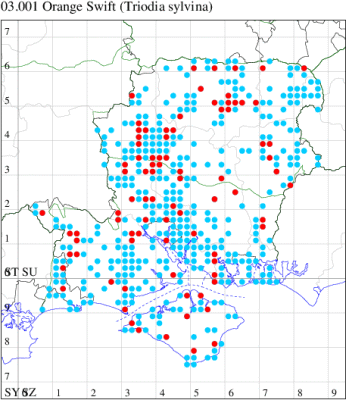
Records by year
Records by week (adult)
Records by week (larval)
Record Summary
VC10: Earliest: Cowes, 18 Aug, 1 (DNor) Latest: Shanklin, 08 Sep, 1 (IOut) Max count: Totland, 03 Sep, 3 (RTer)
VC11: Earliest: Winter Down Copse, Little Somborne, 11 Aug, 1 (GCE) Latest: Fordingbridge, 17 Sep, 2 (SCT) Max count: West Meon, 03 Sep, 17 (RJD, MLO, DWal, KJW)
VC12: Earliest: Goodworth Clatford, 09 Aug, 1 (JMor) Latest: Alton, 17 Sep, 1 (DBO) Max count: Wherwell, 30 Aug, 27 (GCE)
03.002 [B&F: 0017] Common Swift Korscheltellus lupulina (Linnaeus, 1758) - Common
Common in grassland, woodland rides and gardens, and on roadside verges, moorland and heathland throughout most of the British Isles, but local in Scotland and mainly coastal in Ireland. In Hampshire and on the Isle of Wight generally widespread and common, often abundant. Wingspan male 25-33 mm, female 32-40 mm. Variable, often fairly plainly marked, especially the females. Larva feeds on the roots of grasses and a wide range of wild and cultivated plants.
Records prior to 2021
| Vice County | #Records | #Individuals | First Record | Last Record |
|---|---|---|---|---|
| 10 | 580 | 1964 | 1849 | 2020 |
| 11 | 2566 | 5712 | 1951 | 2020 |
| 12 | 1296 | 4774 | 1951 | 2020 |
2021 records
| Vice County | #Records | #Individuals | Max Quantity |
|---|---|---|---|
| 10 | 52 | 155 | 45 |
| 11 | 123 | 405 | 62 |
| 12 | 66 | 286 | 80 |
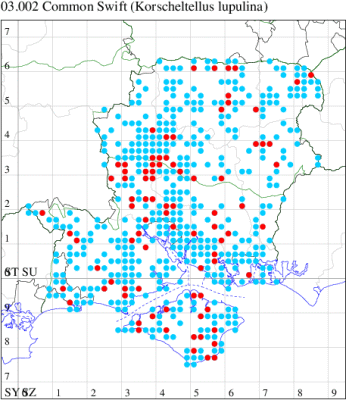
Records by year
Records by week (adult)
Records by week (larval)
Record Summary
VC10: Earliest: Cranmore, 27 May, 1 (CHic) Latest: Wydcombe, 08 Jul, 1 (JRB, IOut) Max count: Osborne Valley Walk, 15 Jun, 45 (IOut)
VC11: Earliest: Broughton, 27 May, 1 (GCE) Latest: Broughton, 08 Jul, 1 (GCE) Max count: Broughton, 13 Jun, 62 (GCE)
VC12: Earliest: Pamber Forest, 28 May, 4 (GJD) Latest: Great Haughurst Copse, Axmansford, 08 Jul, 1 (ACB, GJD) Max count: Little Somborne, 28 May, 80 (GCE)
03.003 [B&F: 0018] Map-winged Swift Korscheltellus fusconebulosa (De Geer, 1778) - Local
Local on moorland and heathland, and in open woodland and rough pastures throughout much of the British Isles. In Hampshire very local amongst Bracken, with strongholds in Crab Wood in vice-county 11 and Pamber Forest in vice-county 12; ). On the Isle of Wight, one on Luccombe Down in 2015 was the first record since the start of the 20th century.
Wingspan 32-50 mm. Distinguished from its congeners by the conspicuously barred cilia of fore- and hindwing (MBGBI Vol 1). Larva feeds within roots of Bracken, over-wintering twice, also found in areas where Bracken does not occur, where the foodplant may be Red Fescue.
Records prior to 2021
| Vice County | #Records | #Individuals | First Record | Last Record |
|---|---|---|---|---|
| 10 | 6 | 3 | 1855 | 2020 |
| 11 | 39 | 65 | 1951 | 2020 |
| 12 | 102 | 225 | 1951 | 2020 |
2021 records
| Vice County | #Records | #Individuals | Max Quantity |
|---|---|---|---|
| 11 | 2 | 2 | 1 |
| 12 | 4 | 7 | 4 |
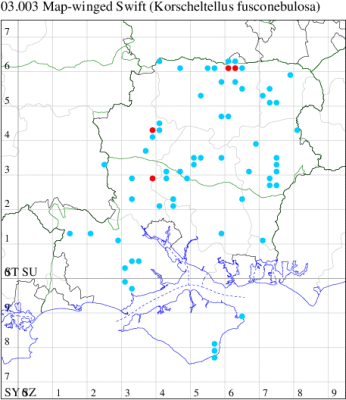
Records by year
Records by week (adult)
Records by week (larval)
Record Details
VC11: Kings Somborne, one, 29 Jun; one, 09 Jun (GCE);
VC12: Harewood Forest, one, 01 Jun; one, 01 Jun (GCE); Pamber Forest, four, 09 Jun; one, 11 Jun (GJD)
03.004 [B&F: 0016] Gold Swift Phymatopus hecta (Linnaeus, 1758) - Local
Local in grassland throughout most of the British Isles. In Hampshire locally common wherever there is bracken, rather uncommon on the Isle of Wight. The males sometimes swarm just before dusk over grassy places adjacent to stands of foodplant. Wingspan male 26-30 mm, female 28-32 mm. The golden markings on forewing of male are diagnostic; in particular, the diagonal, sometimes broken band near base runs roughly parallel to outer markings, unlike other swift moths (MBGBI Vol 1). Larva feeds within roots of Bracken, over-wintering twice.
Records prior to 2021
| Vice County | #Records | #Individuals | First Record | Last Record |
|---|---|---|---|---|
| 10 | 6 | 3 | 1972 | 2010 |
| 11 | 208 | 236 | 1951 | 2020 |
| 12 | 125 | 155 | 1940 | 2020 |
2021 records
| Vice County | #Records | #Individuals | Max Quantity |
|---|---|---|---|
| 11 | 1 | 2 | 2 |
| 12 | 4 | 4 | 1 |
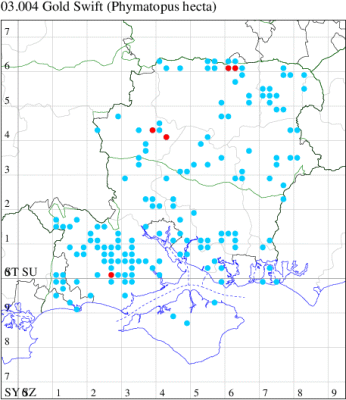
Records by year
Records by week (adult)
Records by week (larval)
Record Details
VC11: Setthorns Inclosure, NF, two, 23 Jun (PBar);
VC12: Harewood Forest, one, 01 Jun; Barton Stacey, one, 10 Jun (GCE); Pamber Forest, one, 10 Jul; one, 24 Jun (GJD)
03.005 [B&F: 0014] Ghost Moth Hepialus humuli (Linnaeus, 1758) - Local
Common in rough meadows and grassland throughout much of Britain and Ireland, but excluding the Isles of Scilly, a species of conservation concern under the UK Biodiversity Action Plan. Widespread in Hampshire and on the Isle of Wight but local and declining. The males have leks in grassy places on downland and in meadows where they fly in numbers at dusk, and the females wander, presumably on egg-laying missions, and come occasionally to light. Wingspan male 44-46 mm, female 46-48 mm. Unmistakable. The larva is polyphagous in the root systems of many grasses and herbaceous plants such as Stinging Nettle and Hop, over-wintering twice.
Records prior to 2021
| Vice County | #Records | #Individuals | First Record | Last Record |
|---|---|---|---|---|
| 10 | 126 | 131 | 1908 | 2020 |
| 11 | 799 | 775 | 1946 | 2020 |
| 12 | 414 | 458 | 200 | 2020 |
2021 records
| Vice County | #Records | #Individuals | Max Quantity |
|---|---|---|---|
| 10 | 6 | 7 | 2 |
| 11 | 12 | 13 | 2 |
| 12 | 4 | 5 | 2 |
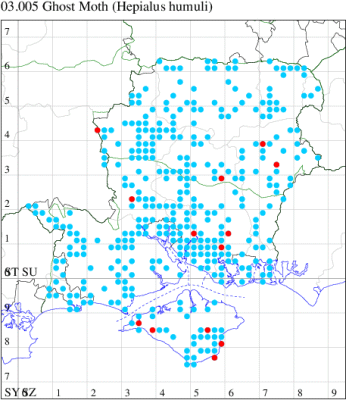
Records by year
Records by week (adult)
Records by week (larval)
Record Details
VC10: Freshwater, one, 01 Jul; Brook Down, one, 07 Jul (PBar); Wheelers Bay, one, female, 20 Jul (ABut); Haseley Manor, one, 13 Jul; two, 19 Jul; Shanklin Upper Chine, one, 18 Jul (IOut);
VC11: Stanbrige Earls, one, female, 25 Jul (JRM); Wickham, one, to light, female, 09 Jul (KCok, RJD, MLO, ADT, KJW); Botley, one, 21 Jun; one, 07 Jul; one, 31 Jul; one, 08 Jul; one, 13 Jul; one, 14 Jul; two, 18 Jul; one, 26 Jul (SLB); Wickham, one, 09 Jul (JRDS); West Walk, one, female, 04 Jun (RJD, MLO, DWal, KJW);
VC12: Cholderton, one, 02 Jul (TJN, LFom, HEdm); Hinton Ampner, one, field observation, male lekking, 14 Jun (ASD); Alton, two, 11 Aug (BCA); Selborne, one, 27 Jul (CJP)
()(IMG_5670).jpg)
(female)(IMG_5958).jpg)